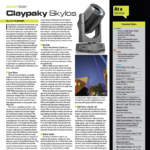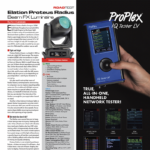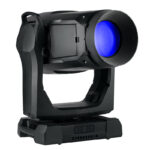Astera has been in the wireless LED luminaire market for some time now, with their flagship AX line of lights leading the market in terms of reliability, ease of deployment and use and cost effectiveness. Today, we’re looking at the Astera AX1 Pixel Tube, a linear cylinder of LED lights.

The Pixel Tube
The Pixel Tube is a cylindrical light that bears a rudimentary resemblance to a standard fluorescent tube, with an external housing composed of translucent white polycarbonate, which effectively diffuses and blends the LEDs inside. Sixteen RGBW pixels run the length of the tube, for a total power of 28 watts. Charging is accomplished via a case with an integrated power supply and eight charging docks, or individually with an AC adapter.

The unit, which is just a touch over a meter long (1,035mm), comes with several hardware accessories that allow it to be rigged in a variety of situations and in many orientations. Included is an eyebolt that screws into a top receptacle for hanging the light vertically in the air, two “holders” — small articulating clamp-like devices that accept rigging hardware and grab onto the light like hands and a three-legged stand, which screws into the bottom of the light for floor mounting. The Pixel Tube has a runtime of up to 20 hours, with the precise timing dependent on several variables: which colors the user selects, brightness, effects, and the temperature of the surroundings. Runtime settings are available in the application, allowing the user to input a desired runtime from one to twenty hours, and the lights will automatically throttle their brightness back in order to achieve that runtime. Color mixing is as expected from an RGBW system, and the lights use the “Royal blue” LEDs for deep blue hues. Light is emitted from only one “side” of the tube, in a 180° arc, with the electronics taking up the other side of the tube.

Control and Output
The Pixel Tube generally requires around five to six hours to completely charge, depending on the ambient temperature. In extreme temperature scenarios, charging can take up to 20 hours, as there is a direct correlation between increased ambient temperature and increased charge time, though a full 20-hour recharge is unlikely in a typical usage scenario. Further, they can also be run when plugged in, like a normal luminaire.
The units all come with color calibration, which ensures consistent color across multiple devices. The calibration algorithm intelligently detects when the user selects a “pure” color (red, green, or blue) and suppresses the mixing of other colors into the final output so that true primary colors are achievable, which is a nice touch absent from some other devices on the market. Dimming is quite smooth across the entire range, with no noticeable stepping — it looks as though Astera is interpolating and smoothing the incoming signal somewhat. The dimming curve, which closely follows a square law, is not adjustable, and color stayed consistent throughout the dimming range.
Control is done completely wirelessly; there is no physical DMX input. Instead, users can control the lights either via the Astera App (Android-based devices currently, IOS is in the works.) which communicates via Bluetooth to an AsteraBox wireless control box, via CRMX / WDMX wireless protocols, or via a small remote control. Addressing the Pixel Tube will always need to be done in the app, as they lack a menu system — simply touch the appropriate light in the app and the chosen light highlights itself so you can easily find it in a sea of others. Features like auto-addressing groups of fixtures is here too, and once patched, the application can send a table of DMX addresses and channels back to the user via e-mail or text message. The Astera App allows for complete control over the units, including not only color and brightness but effects, programs, and color temperature. It also monitors the lights with a feature Astera calls “Talkback+”, an RDM-like feature that reports battery and signal strength, runtime, and addressing information.
For those who need it, there’s also a sound-activated mode built into the AsteraBox, which has an integrated microphone. For applications such as special events or concerts, the Pixel Tube can be fully pixel-mapped, and the user can run bitmap or video content over the tubes through a media server or control every element via DMX.
The lights are also completely silent, relying on radiative cooling for thermal control, a feature that should be very useful for sound-sensitive special events such as weddings.
Although the small size and wireless nature of these units might make them attractive for pilferers, Astera has included an anti-theft system on the lights that sounds an alarm and alerts the operator within the app if certain movement conditions are met. The alarm is moderately loud but persistent and should be enough to deter the casual thief from attempting to walk away with the lights.
![]()
At a Glance
Super-Easy Setup: Just Place and Go
The Astera Pixel Tube, like the other products in the AX-range of lights, shows just how easy wireless LED lighting can be — just put in place and go. Controlling without a console is easy for smaller shows with the free app or the infrared remote, while the wireless DMX capability allows easy use on larger events. The wireless nature allows incredibly easy and fast deployment with a minimum of labor, which saves on both labor and equipment costs as well as time, and the product should easily find a place on corporate events, weddings, or anywhere fast and easy deployment is a must.
Astera Pixel Tubes
PROS: Extremely easy to deploy, runtime setting very convenient, wireless control, IP65-rated
CONS: None
SPECS
- Length: 1 meter+ (40.75”)
- Weight: 2.2 lbs.
- Wattage: 28 watts
- Accessories: 3 leg floor stand, hanging hook,
MSRP: AX1: $390; AsteraBox control box: $335
Manufacturer: Astera
More Info: www.astera-led.com



